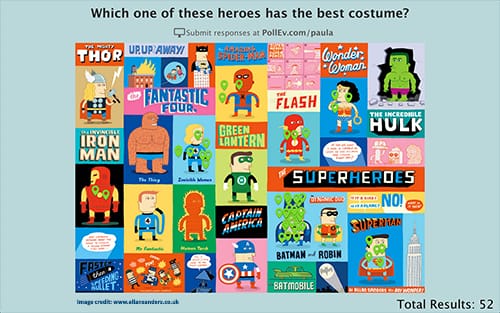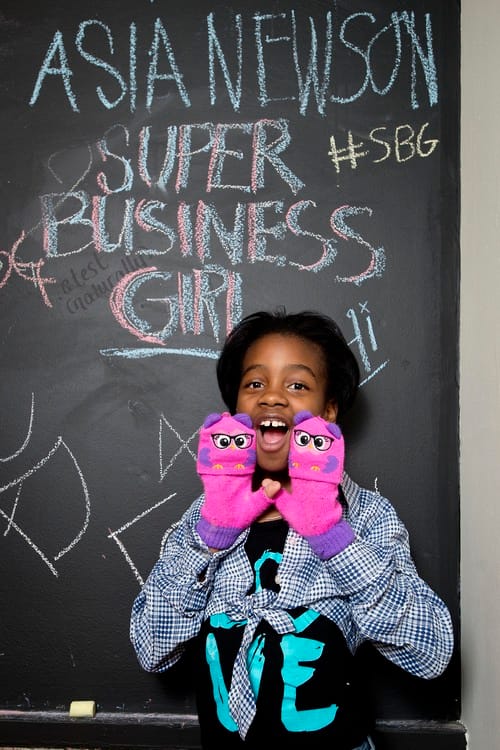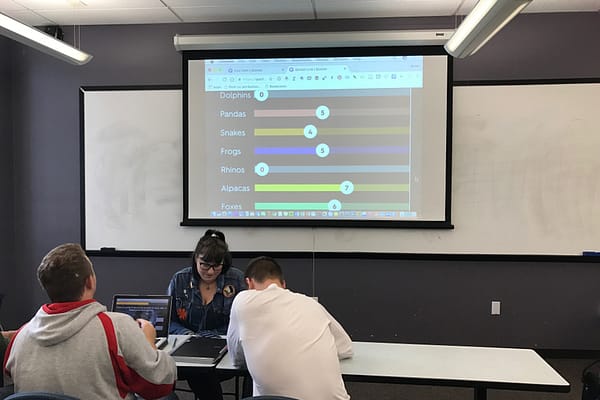
One of my colleagues tried out open-ended polls for the first time the other day. I asked him to let me know how it went, if he had time afterward. Here is his [edited] reply:
“I ended up using PollEverywhere in three of my classes yesterday. It seemed that students enjoyed the interactive nature of the review session. However, there were some challenges.
I did the open-ended polls for the review questions. Initially things went pretty smoothly; however, in both of my intro classes there were one or two students who anonymously posted unhelpful responses (i.e. YouTube links, comments on NFL, etc.) as the class progressed. It was fairly distracting for other students.
In the future, I’m thinking that I may need to assign an identified “scribe” for each group and only allow them to post their group responses. The upper division class did a good job staying on topic.”
His reflections reminded me of another person who had shared about her poll responders going rogue. She teaches classes of 200-300 and had a bad first experience using open-ended questions, as well. She had left the open-ended question showing on the screen as the students worked on the case. After about 20 minutes, it was a free-for-all for who could come up with something to type that would elicit the most laughter from the room.
Here are some ideas for how to have a better experience with polling, specifically with open-ended questions.
Incorporate Polling Early in a Class
In both cases where polling didn’t turn out to work as well as the professors had hoped, they had started using it in the middle or at the end of a 15-week semester. This is not to say that you couldn’t ever make that work.
However, my experience is that especially as our Spring semester draws to a close, the students are often ready to be done about 2-3 weeks before the semester has actually ended. Bringing in a new teaching approach might bring new energy during a challenging season. However, it also might bring out the temptation to destress though distraction.
By using polling earlier in the class, you can set some group norms around how you will use them and be able to establish more familiarity with the method. I typically use polling the first or second class session, with the majority of the questions posed being in multiple choice format, or as a clickable image.

Present a Puzzle or an Opportunity to Predict
In Ken Bain’s What the Best College Teachers Do (2004), he stresses the importance of giving students problems to solve that are intriguing and even beautiful. When he was on Teaching in Higher Ed, episode 36, he asserted that we should:
“Ask engaging questions that spark people’s curiosity and fascination that people find intriguing…”
James Lang’s Small Teaching (2016) describes the power of having students make predictions. He suggests, “When presenting cases, problems, examples, or histories, stop before the conclusion and ask students to predict the outcome.” I enjoy using an episode of Planet Money about Brazil’s wild currency fluctuations and pausing it partway through to ask students what they thought the economists recommended to create more stability in their economic system.
Both Bain (2004) and Lang (2016) stress the importance of heightening learners’ curiosity. If they are being asked to wrestle with something that truly has their attention, they are much less likely to want to share the highlights of last night’s NFL game.

Lang shares about research reported in Scientific American where participants were asked to indicate their level of curiosity. The more curious they were, the more likely they were to remember the information being presented. The combination of curiosity plus the anticipation of receiving an answer created a wonderful combination to maximize both attention and retention.
Go with It
Depending on the nature of what is being entered into the open-ended prompt, consider enjoying the opportunity for some levity in what can all too often be a stressful season.
I followed Stephen Brookfield’s recommendation of using a backchannel service called Today’s Meet and kept it open as I played a couple of segments from a This American Life podcast episode about entrepreneurship.
The first segment profiled Asia Newson, an 11 year-old who was making her mark in business through her sales abilities and dynamic personality. She referred to herself as Super Business Girl and had even crafted an addicting theme song for herself that still gets stuck in my head each time I remember it.
I had asked the students to note when the podcast episode discussed any of our learning objectives and to make those connections on either Today’s Meet, or visually on a large piece of paper I had hung on the wall (this technique is often called Chalk Talk). Side note: I’m not sure what possessed me to think that having both options was a good idea, but I likely would only offer up one mode of collective note taking in the future.
Before I knew it, someone in the class had entered the Today's Meet back channel with the name Super Business Girl. The class burst out in laughter with each additional line that appeared. Eventually, a Super Business Boy came on the scene. The two interacted with each other and had us cracking up each time either name was mentioned for the rest of the semester. I could have been frustrated by the ‘distraction.' Instead, I was grateful for the memory we shared as a class. Each time I have done this exercise with subsequent groups, I always hope maybe one of them will show up again.
Stephen Brookfield shares about a fictitious character he often brings into his teacher who he calls Shannon. This individual argues with Brookfield about controversial topics, in the hopes of getting the students to feel comfortable expressing diverse views. Shannon also provides Stephen with ways he could have approached something in a better way. The students all know that Shannon is not a real person (and that it is Brookfield bringing this character into existence).
Limit the Amount of Time the Open-Ended Poll Stays on the Screen
Probably the most powerful way that I have found to keep open ended questions’ responses more targeted is to limit the amount of time the poll question is left “open” on the screen.
I usually present the question on a slide (not a live, polling slide). Then, much of the time, I will have students discuss their answer with someone near them. Finally, I will bring up the live polling slide on the screen and ask students to respond to it on their devices. If I have done an effective job at creating a mystery, or asking them to solve an intriguing question, I very rarely have any answers that don’t relate to what we are discussing.
Use a Tool that Has a Moderating Feature
Many polling and audience response systems that I am familiar with have the option to moderate responses on their paid plans. I haven’t used moderation much in my teaching, but can imagine that I would need to assign that task to someone in the class. I doubt that I would be able to multitask that effectively, without slowing down the class considerably and losing people’s attention.
Have Names Be Public
If you use a paid plan for PollEverywhere, for example, you can require that students’ names be included with their responses. I am not a huge fan of this option, as it can create unwanted pressure for the students to perform in cases where there is a right/wrong answer. I want these opportunities for review in class to be low stakes and having students’ identities not be known is one of the ways I accomplish this.
Stephen Brookfield stresses the importance of anonymity in his teaching philosophy. His fictional character Shannon isn't the only anonymous person who enters his classes. He suggests that all students use nicknames in their backchannel and uses this same practice when presenting at conferences, as well.
There may be reasons why having your students' names be public makes sense in your case. However. I have yet to see this feature anywhere but on paid polling systems.
Check Your Power
I find it important to reflect on why it bothers me so much when students do certain things. I remember vividly how personally I would take cheating, which I talk about on episode 19 with James Lang and on episode 157 with Phil Newton.
I have yet to take it personally when a student types something distracting into an open-ended poll question (it usually makes me laugh; they can really be quite amusing). But, that doesn’t mean that I couldn’t regularly use a dose of checking my own sense of power in my teaching.
When presented with students who are typing in text that doesn’t align with our plans for the class session, it can mess with our desire to have things be in control. Let’s get real and admit that probably should have been stated as our desire to be the one in control.
Handing control and agency over to our students can be challenging and exhilarating all at the same time. This semester I had options in the syllabus for students to do reviews for our exams. One of the requirements was that they involved the students in the class in some way and didn’t just present from a powerpoint. Seeing them take more of a shared responsibility for the learning that needed to take place in the class was delightful.
Having students give presentations in a class is an activity that probably requires its own post, since there are plenty of ways we can mess this up, as well. But, for now, realize that reflecting on those elements of our frustration are the result of losing control can be helpful in identifying remedies that will ultimately facilitate greater learning in the future.
Tools
I mentioned PollEverywhere in this post, as it was ultimately what I recommended to this colleague, based on the time he had and the goals he was looking to accomplish. Here are a few tools I have found particularly helpful at presenting poll questions:
- Glisser – This is a tool I use more when I am presenting keynotes or workshops at conferences. It allows you to present your slides within their system (you upload your slide deck to Glisser), deliver poll questions, and has a whole host of other options that you can toggle on/off.
- Sli.do – Present live Q&A and polls in events or classes. Again, I tend to use this one more at conferences, instead of in my classes, but you certainly could use it.
- Plickers – If you want to do away with devices completely, Plickers are for you. You print out Plicker cards and students use them to indicate their answers. No open-ended questions for these cards, but I did want to include them here, if you are particularly adverse to having people use their devices.
- PollEverywhere – One of the things I really like about PollEverywhere is all the different types of questions they offer. It is also great how easy it is to embed PollEverywhere questions within a slide deck, meaning that I don’t even have to toggle over to a separate application. Ah yes. One more thing: I like how I can administer a PollEverywhere poll without even a projector. I was once locked out of my classroom. We went out by a beautiful fountain on our campus and were all able to go through the PollEverywhere questions via my phone or tablet and with the students responding on their phones.
- Kahoot – More on the playful side, “Kahoot is a game-based learning and trivia platform. It is restricted to multiple choice questions, but thought it was worth including here.
Other tools I have heard good things about, but haven't tried myself include: TopHat Classroom, Socrative, and Mentimeter.
Don’t forget that you can use sticky notes, place review terms in envelopes and use all sorts of analog methods of reviewing information in a class. The more we can mix it up in our teaching, the more likely we are to combat some of the apathy that can come our way.
Your Turn
What’s your advice to someone who struggles with students typing in distracting items into an open ended polling question?
References
Bain, K. (2004). What the best college teachers do*. Cambridge, Mass.: Harvard University Press.
Lang, J. M. (2016). Small teaching: everyday lessons from the science of learning*. San Francisco, CA: Jossey-Bass.
This American Life (2014, September 5). 533: It’s Not the Product, It’s the Person. Audio podcast. Retrieved from https://www.thisamericanlife.org/533/its-not-the-product-its-the-person





I read last week that Todays Meet is shutting down. See this post from Richard Byrne for more information and for Todays Meet (back channel) alternatives:
http://www.freetech4teachers.com/2018/04/todaysmeet-is-shutting-down-six.html#.Wu3nntMvxBw
-B